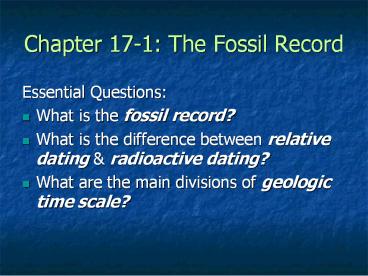Chapter 17-1: The Fossil Record PowerPoint PPT Presentation
Title: Chapter 17-1: The Fossil Record
1
Chapter 17-1 The Fossil Record
- Essential Questions
- What is the fossil record?
- What is the difference between relative dating
radioactive dating? - What are the main divisions of geologic time
scale?
2
- Half of a Half of a Half . . .
- Some forms of chemical elements are unstablethat
is, they break down into other substances. Like
the decay of leftovers in your refrigerator, this
breakdown takes place over time. Unlike those
leftovers, however, the breakdown of unstable
forms of an element progresses in a very orderly
wayby decaying into halves.
3
- 1. Using your ruler, draw a line 24 cm in length
on a sheet of paper. Make a mark at the halfway
point (12 cm). - 2. Then, divide this 12-cm segment in half,
making a mark at 6 cm. Continue in this way,
dividing each progressively smaller segment in
half (ignoring all of the other segments) until
it becomes too small to accurately measure. - 3. Now count each progressively smaller
half- segment. How many segments did you count?
4
- Fossils ancient life
- Paleontologist study fossils
- Fossil record
- Provides evidence of history of life on Earth
- Shows how different organisms have changed over
time - 99 of species that have lived on Earth now
extinct
5
- How fossils form
6
- Interpreting fossil evidence
- Relative dating
- Position of sediment beds relative to each other
gives relative ages
7
- Radioactive dating
- Isotope form of element with different numbers
of neutrons - Ex C12 C14 2 extra neutrons in C14
- While a sample is losing neutrons, its
radioactive - Amount of time for ½ of isotopes in sample to
revert to stable form is its half-life - For C14 ? 5440 years
- If we look at of C14 C12
- Ex 25 C14 75 C12
- 2? 10,880 years old
- Other isotopes decay more slowly
- Potassium ? 1.3 billion years
8
- Geologic time scale
- Eras and periods defined by major changes in the
fossil record - Divisions are not
- even amounts
- Ex Precambrian
- era about
- 90 of Earths
- history
PowerShow.com is a leading presentation sharing website. It has millions of presentations already uploaded and available with 1,000s more being uploaded by its users every day. Whatever your area of interest, here you’ll be able to find and view presentations you’ll love and possibly download. And, best of all, it is completely free and easy to use.
You might even have a presentation you’d like to share with others. If so, just upload it to PowerShow.com. We’ll convert it to an HTML5 slideshow that includes all the media types you’ve already added: audio, video, music, pictures, animations and transition effects. Then you can share it with your target audience as well as PowerShow.com’s millions of monthly visitors. And, again, it’s all free.
About the Developers
PowerShow.com is brought to you by CrystalGraphics, the award-winning developer and market-leading publisher of rich-media enhancement products for presentations. Our product offerings include millions of PowerPoint templates, diagrams, animated 3D characters and more.

